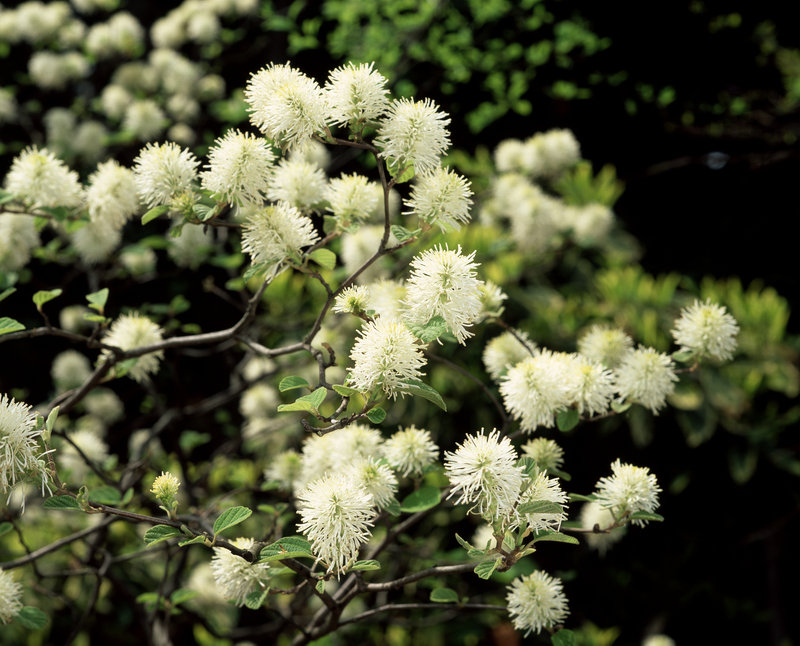Nurturing a Vibrant Herb Haven with Ease
Posted on 14/08/2025
Nurturing a Vibrant Herb Haven with Ease: Your Ultimate Guide
Imagine stepping out your door and harvesting fresh, fragrant herbs for tonight's dinner or a restorative tea. Envision a lush collection of basil, mint, rosemary, and thyme thriving in your home, whether on a balcony, kitchen windowsill, or backyard plot. Creating a flourishing herb sanctuary is well within your reach--no green thumb required! In this comprehensive guide, discover the secrets to cultivating a vibrant herb haven with ease, so you can enjoy a bounty of aromatic and flavorful herbs all year round.

Why Create Your Own Herb Garden?
Before we dive into the practical how-tos, let's explore the many benefits of nurturing an herb paradise at home:
- Freshness and Flavor: Nothing elevates your dishes like just-harvested green herbs.
- Cost Efficiency: Growing herbs saves money compared to purchasing fresh or dried varieties.
- Health Benefits: Many herbs have medicinal properties and can naturally boost your well-being.
- Eco-Friendly: Homegrown means zero food miles, no plastic packaging, and minimal waste.
- Therapeutic Value: Gardening itself lowers stress and fosters mindfulness.
With such rewards, it's no wonder more and more people are cultivating their own herb havens with ease!
Choosing the Perfect Location for Your Herb Garden
Location matters when nurturing lush, vigorous herbs. Your chosen spot influences growth, flavor, and yield. Consider the following:
Sunlight Requirements
- Herbs thrive in at least 6-8 hours of direct sunlight daily. South-facing windows, balconies, or garden beds are ideal.
- If you have limited light, opt for shade-tolerant herbs like mint, parsley, and chives.
Indoor vs. Outdoor Herb Havens
- Indoor gardens are great for year-round harvesting and for those with small spaces.
- Outdoor beds offer more room and typically result in larger, more robust plants.
- Consider space, light, accessibility, and climate before deciding.
Selecting the Best Herbs for Your Haven
Starting with the right herbs is essential to nurturing a flourishing herb sanctuary with ease. Beginners may want to focus on reliable, productive varieties. Here are popular and easy-to-grow herbs to start your garden:
- Basil: Perfect for summer, loves warmth and sunshine.
- Mint: Vigorous and nearly indestructible -- best in containers to prevent spreading.
- Rosemary: Drought-tolerant with robust flavor and ornamental value.
- Thyme: Compact, aromatic, and ideal for pots or ground covers.
- Parsley: Hardy and multipurpose -- choose curly or flat-leaf varieties.
- Oregano and Sage: Mediterranean classics, thrive in similar conditions as thyme and rosemary.
- Chives: Easy to grow, great for garnishing.
- Cilantro: Cool-season herb, best sown in early spring or fall.
Dream big, but start with a handful of favorites as you develop your green thumb!
Essential Tools & Supplies for Effortless Herb Gardening
Gathering basic equipment will ensure easy care for your dazzling herb garden:
- Herb containers or pots: Ensure good drainage.
- Quality potting mix: A light, well-draining soil enriched with compost.
- Watering can or gentle sprayer: Prevents soil disruption.
- Sharp scissors or pruners: For harvesting with minimal damage.
- Plant markers: Helpful when sowing multiple herbs.
- Mulch: Retains moisture and suppresses weeds outdoors.
- Organic fertilizer: Boosts lush growth with minimal effort.
Step-by-Step: Planting Your Vivid Herb Sanctuary
1. Plan Your Layout
- Group herbs with similar sun, water, and soil needs for simple maintenance.
- Arrange taller herbs like rosemary or dill at the back, and compact ones like thyme at the front.
2. Prepare the Soil or Potting Mix
- Good drainage is key! Mix sand or perlite into heavy soils.
- Add compost for slow-release nutrients. Rich, loose soil equals happy herbs.
3. Planting Seeds or Seedlings
- Seeds: Sow according to the packet instructions, pressing gently into the soil.
- Seedlings: Dig a hole slightly larger than the root ball, set in place, and cover with soil. Water well.
4. Watering Wisely
- Let soil dry out slightly between waterings; most herbs dislike soggy roots.
- Water at the base, not over the leaves, to prevent disease.
- Use mulch to retain moisture in outdoor settings.
5. Regular Feeding
- Use an organic, all-purpose fertilizer every 4-6 weeks during active growth.
- Over-fertilizing can harm flavor, so err on the side of less is more.
Expert Tips for Effortless, Lush Growth
- Pinch and Harvest Often: Frequent cutting encourages bushier growth and delays flowering.
- Rotate Indoor Herbs: Turn pots every week for even light exposure.
- Monitor for Pests: Aphids, spider mites, and whiteflies can be controlled with neem oil or insecticidal soap.
- Prune Flowers: Regularly snip off flower buds (especially basil) to keep the plant focused on leafy growth.
- Winterize Perennials: Bring sensitive plants indoors or cover outdoors for overwintering.
- Label Plants: Especially helpful if sowing a wide assortment of herbs.
Combating Common Herb Growing Challenges
Poor Growth
- Check sunlight: Move plants to a sunnier location if needed.
- Soil compaction: Aerate and amend with compost for improved drainage.
Pest Infestation
- Spray affected herbs with a mild soap solution.
- Hand-pick larger insects and remove diseased leaves.
- Encourage beneficial insects like ladybugs.
Overwatering Issues
- Allow soil to dry between watering sessions.
- Repot into a container with better drainage if roots appear waterlogged.
Creative Ideas for a Spectacular Herb Oasis
Once your herb-rich sanctuary is established, the possibilities are endless! Here are some creative inspiration points:
- Kitchen Counter Herb Garden: Small pots of basil, parsley, and chives make meal prep a delight.
- Vertical Herb Walls: Wall-mounted containers maximize limited space and create living decor.
- Hanging Baskets: Trailing herbs like oregano and thyme add dimension to balconies.
- Herb Spiral Gardens: These beautiful mounds provide varied microclimates for different herb needs.
- Windowsill Gardens: Perfect for sun-loving herbs in urban spaces.
Year-Round Enjoyment: Harvesting and Preserving Your Herbs
Best Time to Harvest
- Pick herbs in the early morning, just after the dew evaporates and before the sun evaporates essential oils.
- Snip regular amounts from each plant--never strip entirely, as this can stress the plant.
Preserving the Herbal Abundance
- Drying: Hang small bunches or lay on a rack in a well-ventilated, shady spot.
- Freezing: Chop and place herbs in ice cube trays with oil or water for use in winter soups and stews.
- Infused Oils and Vinegars: Bottling herbs in oils or vinegars preserves flavor and makes great gifts.
- Herb Butters or Pestos: Blend with butter or olive oil to keep flavorful condiments on hand.
Infusing Your Life with a Flourishing Herb Retreat
With these simple, accessible steps, creating a vibrant herb haven is genuinely achievable for all, from novice gardeners to seasoned plant lovers. Watch your garden transform into a thriving, aromatic retreat that elevates your meals, enriches your home, and brings you continual joy. Nurturing a lush herb oasis with ease isn't just a rewarding hobby--it's a transformative lifestyle!

Frequently Asked Questions: Nurturing a Flourishing Herb Garden
Which herbs are the easiest for beginners?
Start with forgiving herbs like mint, basil, chives, and parsley. These adapt well to many conditions and offer plentiful harvests with minimal maintenance.
How often should I water my herbs?
Water when the top inch of soil feels dry. Overwatering is a more common mistake than underwatering, especially with Mediterranean herbs like rosemary and thyme.
Can herbs grow indoors year-round?
Absolutely. Provide sufficient light--ideally a sunny windowsill or LED grow lights--and protect from drafty windows or direct heat sources. Rotate pots for even growth.
Can I grow different herbs in the same pot?
It's possible if they share similar water and light needs. Avoid pairing invasive herbs (like mint) with others--they do best in solo containers.
How do I encourage bushier, more abundant herb plants?
Frequent trimming or pinching encourages plants to branch out and become fuller. Always harvest just above a pair of leaves.
Conclusion: Embark on Your Herb Gardening Journey with Confidence
Nurturing a vibrant herb haven with ease is more than a trend--it's a sustainable, enjoyable way to enhance your life. With the right setup, a handful of essential tools, and these expert tips, you can cultivate a thriving herbal escape right at home. Whether your garden is indoors or out, compact or sprawling, every fragrant leaf you harvest is a testament to your care and creativity. Start your journey today--your herb oasis awaits!
Happy gardening, and may your home be filled with green abundance!

